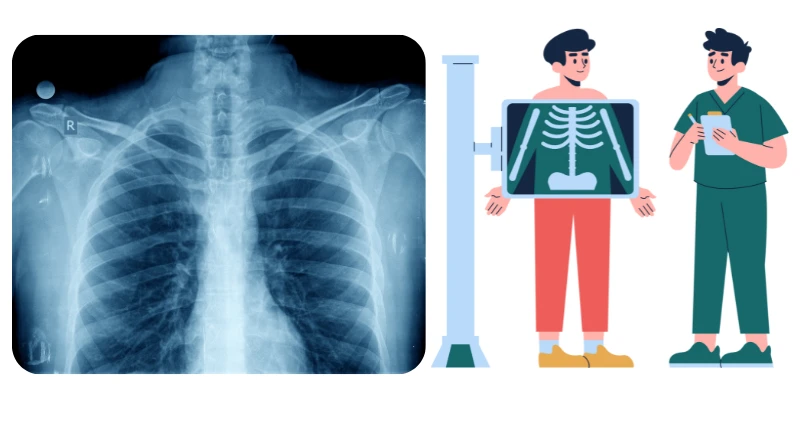When we think of medical tests, X-rays often come to mind as the go-to solution for diagnosing a wide range of health issues.
But did you know that this simple, non-invasive tool can reveal much more than just broken bones? From heart diseases to lung infections, X-rays play a crucial role in identifying conditions that could be life-threatening if left untreated.
Whether you’re seeking answers for personal health concerns or simply curious about medical technology, this guide will shed light on the power of X-rays in modern-day diagnosis.

Introduction to X-Rays
X-rays are a type of electromagnetic radiation used to create images of the inside of the body. Discovered in 1895 by Wilhelm Roentgen, X-rays revolutionized medicine by allowing doctors to visualize internal structures without surgery. In India, X-rays are widely used due to their affordability, accessibility, and reliability.
How Do X-Rays Work?
X-rays penetrate the body and are absorbed by different tissues at varying degrees.
- Bones absorb more X-rays and appear white on the image.
- Soft tissues absorb fewer X-rays and appear in shades of gray.
- Air-filled areas like the lungs appear black.
The resulting image is called a radiograph, which is interpreted by radiologists to diagnose medical conditions.
Types of X-Rays Commonly Used in India
| Type of X-Ray | Purpose | Example |
|---|---|---|
| Plain X-Ray | General imaging | Chest X-ray, limb fractures |
| Dental X-Ray | Oral and dental health assessment | Cavity detection, root canals |
| Contrast X-Ray | Enhanced imaging using contrast agents | Barium swallow, angiography |
| CT Scan (Advanced X-Ray) | Cross-sectional images of the body | Brain, abdomen, cancer detection |
What Conditions Can an X-Ray Diagnose?
1. Bone and Joint Disorders
- Fractures and Dislocations: X-rays are the go-to diagnostic tool for identifying fractures and joint dislocations.
- Arthritis: X-rays reveal joint space narrowing, bone spurs, and other signs of arthritis.
- Bone Infections (Osteomyelitis): X-rays can show bone destruction and changes caused by infections.
- Bone Tumors: Early detection of bone tumors is possible with X-rays.
2. Lung and Chest Conditions
- Pneumonia: X-rays help detect lung infections and their extent.
- Tuberculosis (TB): In India, X-rays play a significant role in TB diagnosis, a prevalent condition.
- Lung Cancer: Abnormal masses can be spotted on chest X-rays.
- Collapsed Lungs (Pneumothorax): Identifiable by air pockets in the chest cavity.
3. Dental Issues
- Tooth Decay: X-rays detect cavities hidden between teeth.
- Jaw Problems: Structural abnormalities like TMJ disorders are assessed using dental X-rays.
- Wisdom Teeth: Impacted teeth can be easily identified.
4. Abdominal Conditions
- Kidney Stones: X-rays can detect the location and size of kidney stones.
- Intestinal Blockages: Detectable through X-ray imaging.
- Foreign Objects: Ingested objects can be identified using X-rays, especially in children.
5. Heart and Blood Vessel Conditions
- Heart Size: An enlarged heart (cardiomegaly) can be observed.
- Aneurysms: Certain types of aneurysms can be detected.
- Calcification: X-rays help identify calcifications in blood vessels.
6. Cancer Detection
X-rays, particularly with advanced techniques like CT scans, help detect various cancers, including lung, breast, and bone cancers.
Advantages of X-Rays in India
- Affordable: X-rays are cost-effective and widely available in government and private healthcare facilities.
- Accessible: Even in rural areas, mobile X-ray units make imaging possible.
- Non-Invasive: X-rays are a painless way to diagnose many conditions.
- Quick Results: X-rays provide instant images for prompt diagnosis.
Limitations of X-Rays
- Radiation Exposure: Although minimal, prolonged exposure can have risks.
- Limited Detail: Some conditions, especially involving soft tissues, may require advanced imaging like MRI.
- Interpretation Issues: Misinterpretation can lead to incorrect diagnosis.
From an Indian Context
In India, the rising prevalence of conditions like tuberculosis, arthritis, and cancer has increased the demand for X-rays.
Government initiatives like Ayushman Bharat have improved access to diagnostic tools for underserved populations. However, challenges remain in ensuring quality standards and timely interpretation, particularly in rural areas.
FAQs
1. Are X-rays safe for pregnant women?
X-rays are generally avoided during pregnancy unless absolutely necessary. If required, proper shielding is used to protect the fetus.
2. How long does an X-ray procedure take?
The procedure typically takes 5-10 minutes. However, preparation and positioning may add a few extra minutes.
3. Can X-rays detect all fractures?
Most fractures are visible on X-rays, but hairline fractures may require a follow-up X-ray or additional imaging like a CT scan.
4. How often can one get an X-ray?
There’s no fixed limit, but unnecessary X-rays should be avoided to minimize radiation exposure.
5. What is the cost of an X-ray in India?
The cost varies from ₹250 to ₹1500, depending on the type and location. Government hospitals may offer free or subsidized services.
Conclusion
X-rays are a cornerstone of medical diagnostics, offering a quick, affordable, and reliable way to diagnose a wide range of conditions.
In a diverse and populous country like India, their role is indispensable. By understanding what conditions X-rays can diagnose and their limitations, patients can make informed decisions about their healthcare.
If you have any questions about X-rays or need further clarification, feel free to ask in the comments below. Your health is your wealth—let’s take proactive steps to safeguard it!

